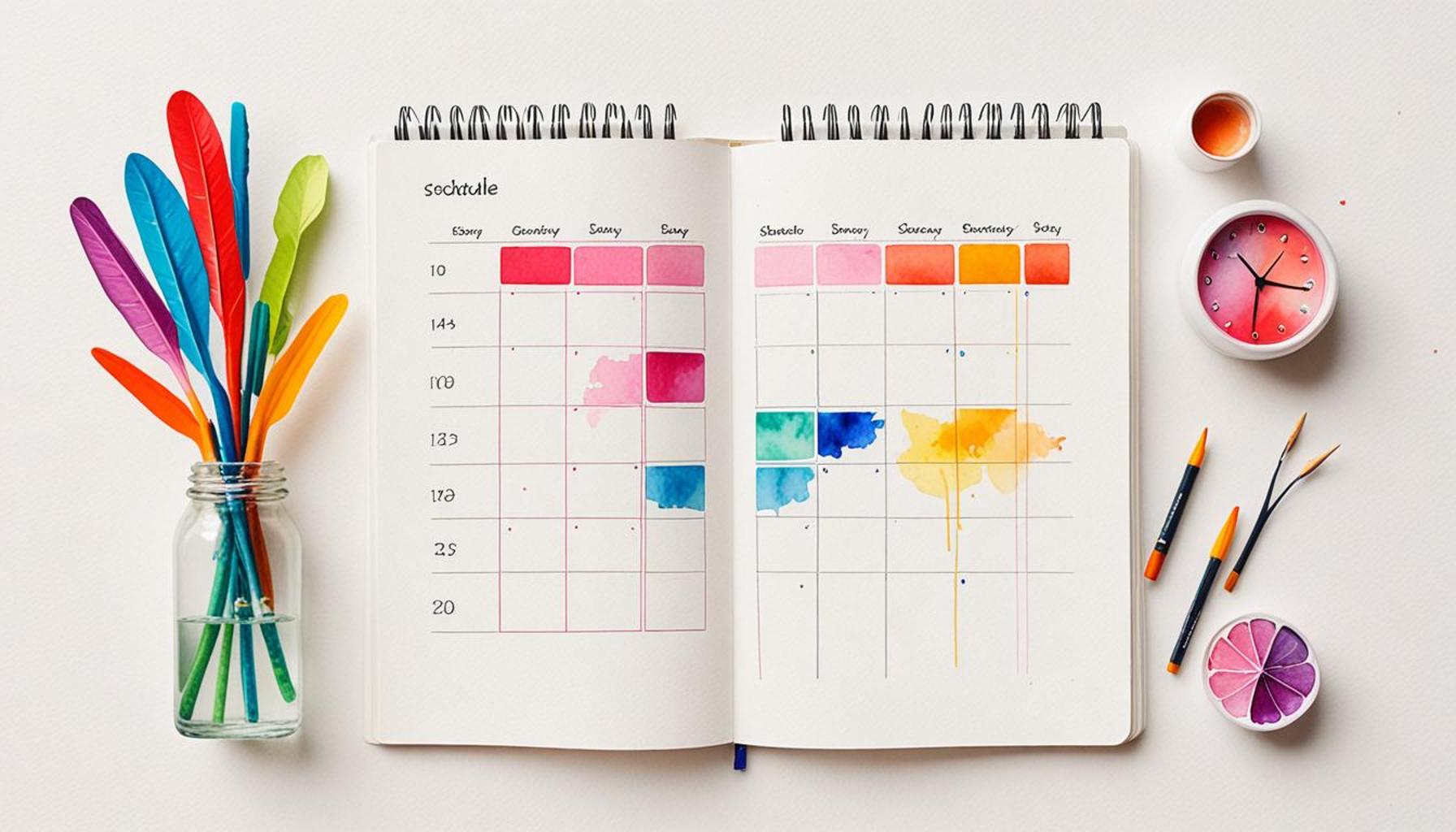The Power of Minimalist Routine: Structuring Your Day for Efficient Time Management

Unlocking Your Day with Minimalism
In a world that often feels cluttered and overwhelming, finding a balance through simplicity is crucial. One effective way to achieve this balance is by implementing a minimalist routine. This approach not only declutters your day but also enhances your efficiency, allowing you to focus on what truly matters. In recent years, minimalism has surged in popularity, becoming a guiding philosophy for many looking to streamline their lives and boost productivity.
But what does a minimalist routine entail? Here are some key features that can help you reshape your daily life:
- Prioritization: Identifying and focusing on essential tasks is at the heart of minimalism. This means evaluating your responsibilities and determining which tasks align most closely with your personal and professional goals. For example, instead of checking emails first thing in the morning, allocate time to tackle the day’s most pressing project. This shift can provide a sense of accomplishment early in the day.
- Time blocking: One of the most effective strategies for maintaining a minimalist routine is time blocking. This technique involves allocating specific time slots for various activities throughout your day, thereby creating a clear structure. For instance, you might designate a two-hour block in the morning for creative work and another block in the afternoon for meetings. This helps prevent distractions and keeps you focused on one task at a time.
- Streamlined processes: Minimizing the complexity of how you handle daily responsibilities can significantly impact your efficiency. This could involve automating certain tasks or using tools like checklists or digital planners. For example, if you often find yourself overwhelmed with grocery shopping, consider creating a weekly meal plan to simplify your grocery list and reduce trips to the store.
By embracing these principles, individuals can regain control over their time and significantly reduce stress. Studies suggest that structured routines lead to increased productivity and satisfaction in both personal and professional spheres. According to a survey conducted by the American Psychological Association, individuals who implement structured routines in their lives report feeling more organized and less anxious.
Consider your daily habits. Are they serving you or holding you back? Adopting a minimalist routine can illuminate this question, enabling you to navigate your day with clarity and purpose. This transformation allows for more meaningful engagement in day-to-day activities, fostering both mental and emotional well-being.
As we delve into the various aspects of structuring your day, you’ll discover practical tips and insights that can reshape your time management strategy. Explore how a minimalist approach can fundamentally change how you view time and enhance your overall quality of life.
LEARN MORE: Click here to discover the 30-day method for decluttering
The Essentials of Crafting a Minimalist Routine
To unlock the full potential of a minimalist routine, it is vital to understand the foundational elements that contribute to its effectiveness. Implementing a minimalist routine is not merely about cutting back; it is about creating a framework that promotes a focused and intentional approach to daily life. Below are several core concepts that can enhance your time management while simplifying your daily responsibilities.
- Mindful Mornings: How you start your day sets the tone for everything that follows. By adopting a mindful morning routine, you can increase your focus and productivity. Consider integrating activities such as meditation, journaling, or light exercise into your morning. These practices encourage a proactive mindset and help you tackle your tasks with clarity and enthusiasm.
- Simplified Decision-Making: The cognitive burden associated with making too many decisions can be draining. Streamlining your choices—such as wearing a uniform, creating a meal schedule, or limiting your social engagements—frees up mental space for critical thinking and creativity. For example, many successful individuals adhere to a specific breakfast regime to eliminate decision fatigue early in the day.
- Regular Review Sessions: Incorporating weekly or monthly review sessions into your routine allows you to assess your progress and adjust your priorities accordingly. This practice can involve reflecting on what tasks you accomplished, identifying areas for improvement, and recalibrating your goals. A structured review session can transform you from a passive participant in your life to an engaged and proactive planner.
- Digital Decluttering: In our tech-driven society, digital distractions can consume an immense portion of our time and attention. Adopting a minimalist routine includes curating your digital life: unsubscribing from unnecessary email lists, organizing your desktop, and setting boundaries for social media usage. Research indicates that people who limit their screen time typically report increased productivity and greater satisfaction in their daily tasks.
The beauty of implementing a minimalist routine lies in its adaptability; you can tailor each component to align with your unique lifestyle and requirements. Various studies highlight that individuals who prioritize simplicity within their daily structures often enjoy higher levels of emotional stability and lower levels of anxiety. A survey by the National Institute of Mental Health indicates that individuals with organized daily routines are less likely to experience burnout and more prone to enjoy greater life satisfaction.
As we immerse ourselves further into the concept of structuring your day around minimalist principles, you’ll begin to uncover more actionable strategies and deeper insights. By embracing these techniques, you pave the way for meaningful engagement and a more profound connection with your time, ultimately fostering a sense of tranquility in your daily existence.
The Importance of Structuring Your Day
Adopting a minimalist routine can be a transformative experience, enhancing your time management skills significantly. By eliminating distractions and unnecessary tasks, individuals can focus on what truly matters. This focus not only helps in achieving daily goals but also promotes a sense of accomplishment. When you structure your day with a minimalist approach, you automatically prioritize your time effectively. Utilizing time blocks allows us to categorize tasks into specific, manageable segments. This method helps reduce procrastination and instills a disciplined environment, whether at work or home.Moreover, implementing a minimalist routine can positively affect mental health. With fewer tasks on your plate, you may experience reduced stress levels. This clear organization leads to improved productivity, as you can allocate time to activities that rejuvenate and inspire you, such as exercise, hobby pursuits, or quality time with loved ones. It’s crucial to remember that efficiency doesn’t only come from doing more but often from doing less with greater impact. As you begin your journey into minimalist routines, consider reassessing your daily commitments and streamlining them towards achieving efficiency and balance.
Implementing Minimalist Techniques
One effective approach is the “two-minute rule,” which states that if a task can be accomplished in two minutes or less, do it immediately. This practical strategy prevents small tasks from piling up and consuming valuable time later. Additionally, adopting tools like to-do lists or digital planners can aid in maintaining focus, ensuring that nothing essential slips through the cracks. By actively integrating these techniques into your daily routine, you may notice enhanced clarity in your objectives and a newfound appreciation for time itself. As you explore the world of minimalist routines, reflect on personal values, and how to align daily activities with those values to achieve a truly rewarding and efficient lifestyle.
DISCOVER MORE: Click here to unlock the secrets of mindful organization
Building Momentum with Consistency
After establishing the essentials of a minimalist routine, the next step is to focus on building momentum through consistency. Developing a daily structure that not only prioritizes simplicity but also encourages habitual practice can drastically enhance your time management capabilities. By implementing and adhering to certain strategies, you can solidify a routine that promotes sustained productivity.
- Batching Tasks: One of the most effective strategies in time management is the art of task batching. This method involves grouping similar tasks together to complete them in a focused block of time. For instance, rather than sporadically checking emails throughout the day, dedicate 30 minutes at the start or end of your work period solely for this task. This approach not only saves time but also reduces the cognitive load associated with constant task-switching.
- Goal-Oriented Time Blocks: Structuring your day around specific goals can significantly amplify your productivity. By allocating time blocks to particular activities—such as “creative work” from 9 AM to 11 AM or “meetings” from 1 PM to 3 PM—you create an environment where your attention is entirely focused on single objectives. Research supports this method, showing that setting aside uninterrupted time for dedicated work leads to higher quality outputs and reduced stress levels.
- The Two-Minute Rule: Popularized by productivity expert David Allen in his book “Getting Things Done,” the Two-Minute Rule can transform how you handle minor tasks. If a task takes two minutes or less to complete, do it immediately instead of adding it to a list. This simple approach helps you maintain momentum throughout the day, ensuring that small tasks don’t accumulate and create unnecessary clutter in your routine.
- The Importance of Breaks: While it might seem counterintuitive, incorporating strategic breaks into your minimalist routine is crucial for long-term efficiency. The Pomodoro Technique, which encourages 25 minutes of focused work followed by a 5-minute break, has been shown to improve concentration and enhance cognitive function. In fact, a study from the University of Illinois found that brief diversions from a task can dramatically improve one’s ability to focus on that task for prolonged periods.
As you develop this consistent flow within your day, it’s important to remain flexible. Life is inherently unpredictable, and rigid adherence to a schedule can sometimes lead to frustration. Embracing adaptability while maintaining your minimalist principles allows for smooth navigation through your responsibilities, potentially leading to more innovative problem-solving and creativity. The National Academy of Sciences found that adaptability in routine not only promotes resilience but also fosters a mindset geared toward growth.
Moreover, tracking your progress through habit-forming apps or a simple journal can provide motivation, offering tangible evidence of how these strategies are transforming your time management efficiency. When you see the fruits of your labor manifesting into increased productivity and reduced stress, you will be encouraged to continue refining your minimalist routine.
Ultimately, the strategies discussed above serve as a testament to the power of a minimalist approach to routine. By prioritizing simplicity, fostering consistency, and nurturing an adaptable mindset, you will cultivate a daily structure that allows for efficient time management and enriches your overall well-being.
DISCOVER MORE: Click here to learn about boosting your productivity through decluttering
Embracing Minimalism for a Productive Future
As we navigate the complexities of modern life, the significance of a minimalist routine cannot be overstated. By carefully crafting a structure that emphasizes simplicity and efficiency, individuals can harness the power of time management to not only meet their professional goals but also enhance their overall quality of life. The strategies discussed—from task batching to implementing the Two-Minute Rule—not only streamline daily activities but also cultivate a mindset geared toward productivity and focus.
Moreover, the flexibility inherent in a minimalist routine fosters resilience; it empowers individuals to adapt to unexpected challenges without losing sight of their objectives. Recognizing the value of strategic breaks as a means to recharge the mind and spur creativity is crucial in sustaining energy levels throughout the day. These principles, combined with the habit-forming techniques explored, guide you in creating a daily rhythm that supports both personal and professional success.
As you embark on this journey, consider viewing your minimalistic routine as a living entity—one that evolves with your needs and aspirations. By committing to less, you can achieve more, liberating yourself from the clutter that often accompanies busy schedules. Allow the power of a minimalist routine to reshape your days, ultimately leading to a brighter, more focused, and fulfilling future.



